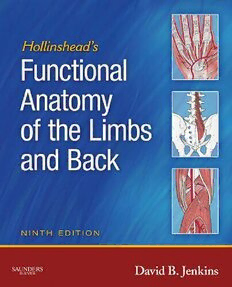Table Of ContentREGISTER TODAY!
To access your Student Resources, visit:
http://evolve.elsevier.com/Jenkins/Hollinshead/
Register today and gain access to:
Answers to chapter Review Questions and
Exercises from the book
WebLinks
An exciting source that lets you link to hundreds
of websites carefully chosen to supplement the
content of the textbook by chapter
Labeling exercises
Exercises that reinforce what you have learned
from the book
This page intentionally left blank
Hollinshead’s
Functional
Anatomy
of the Limbs
and Back
This page intentionally left blank
Hollinshead’s
Functional
Anatomy
of the Limbs
and Back
N I N T H E D I T I O N
DaviD B. Jenkins, PhD
Chair, Department of Growth, Development and Structure
Head, Section of Anatomy
School of Dental Medicine
Southern Illinois University
Alton, Illinois
11830 Westline Industrial Drive
St. Louis, Missouri 63146
HOLLINSHEAD’S FUNCTIONAL ANATOMY OF THE LIMBS AND BACK, NINTH EDITION 978-1-4160-4980-7
Copyright © 2009, 2002, 1998, 1991, 1981, 1976, 1969, 1960, 1951 by Saunders, an imprint
of Elsevier Inc.
All rights reserved. No part of this publication may be reproduced or transmitted in any
form or by any means, electronic or mechanical, including photocopying, recording, or any
information storage and retrieval system, without permission in writing from the publisher.
Permissions may be sought directly from Elsevier’s Rights Department: phone: (+1) 215 239
3804 (US) or (+44) 1865 843830 (UK); fax: (+44) 1865 853333; e-mail: healthpermissions@
elsevier.com. You may also complete your request on-line via the Elsevier website at http://
www.elsevier.com/permissions.
Notice
Knowledge and best practice in this field are constantly changing. As new research and
experience broaden our knowledge, changes in practice, treatment and drug therapy
may become necessary or appropriate. Readers are advised to check the most current
information provided (i) on procedures featured or (ii) by the manufacturer of each product
to be administered, to verify the recommended dose or formula, the method and duration
of administration, and contraindications. It is the responsibility of the practitioner, relying
on their own experience and knowledge of the patient, to make diagnoses, to determine
dosages and the best treatment for each individual patient, and to take all appropriate
safety precautions. To the fullest extent of the law, neither the Publisher nor the Author
assumes any liability for any injury and/or damage to persons or property arising out of or
related to any use of the material contained in this book.
The Publisher
Library of Congress Cataloging-in-Publication Data
Jenkins, David B.
Hollinshead’s functional anatomy of the limbs and back / David B. Jenkins. — 9th ed.
p. ; cm.
Includes bibliographical references and index.
ISBN 978-1-4160-4980-7 (pbk. : alk. paper)
1. Extremities (Anatomy) 2. Back—Anatomy. I. Title. II. Title: Functional anatomy of the
limbs and back.
[DNLM: 1. Musculoskeletal System—anatomy & histology. 2. Movement. 3. Musculoskeletal
Physiology. WE 101 J52h 2009]
QM548.J46 2009
611'.98—dc22
2008034348
Vice President and Publisher: Linda Duncan
Executive Editor: Kathy Falk
Senior Developmental Editor: Christie M. Hart
Publishing Services Manager: Catherine Jackson
Senior Project Manager: Gena Magouirk-Singh
Design Direction: Jessica Williams
Printed in Canada.
Last digit is the print number: 9 8 7 6 5 4 3 2 1
To the most important people in my life—my wife, Rita, and our family—
Kathie and Daren, Ben and Paige, Tim and Michelle, and grandsons,
Brad, Adam, Josh and Zach—for their love, support, and understanding.
This page intentionally left blank
PREFACE
Dr. W. Henry Hollinshead, while heading the Sec- the internationally accepted Terminologia Anatomica:
tion of Anatomy at the Mayo Clinic, realized a International Anatomical Terminology developed by the
deficiency in available anatomical texts and wrote Federative Committee on Anatomical Terminology.
the first edition of what was then called Functional New “Analyses of Activities and Associated Move-
Anatomy of the Limbs and Back. His basic premise for ments” have been added. These discussions demon-
creating the book was “to provide a readable account strate the correlation between anatomy and function
of that portion of anatomy which is of particular in- and illustrate how they relate to everyday activities. At
terest to those interested in the functions of muscle the end of each chapter, separate sections with review
and movements of the body,” a text which could be questions and exercises have been expanded. These
utilized by the “beginning non-medical student of are included to assist readers in evaluating their un-
muscular movement” and as a “ready reference or re- derstanding of the material and to provide examples
view for the more advanced student or the medical of questions and practical exercises that can be used as
graduate especially interested in this field.” With the a basis for developing additional questions for testing
death of Dr. Hollinshead before work on the sixth comprehension. Since anatomy is such a visual dis-
edition was started, the book’s title was changed to cipline, considerable emphasis has been placed upon
Hollinshead’s Functional Anatomy of the Limbs and evaluation and revision of the artwork. Over 60 new
Back in honor of a friend, mentor, colleague, and su- illustrations have been created to replace some of the
perb anatomist who contributed so much to the dis- original figures. Of the artwork that remains from the
cipline. As the text has evolved through its numerous previous edition, significant changes have been made
subsequent editions, the main coverage has remained in the labeling, content, and color.
true to the title, and it has been expanded to provide I hope you find the ninth edition of Hollinshead’s
a more complete coverage of the body to create a bet- Functional Anatomy of the Limbs and Back to be an
ter resource for those who use the book. informative, user-friendly, and useful resource in
With the ninth edition, additional modifications your studies and career. Anatomy is a fascinating
will be evident. The text has been edited and modified, discipline, particularly when you apply the informa-
and the terminology has been updated to conform to tion functionally and clinically.
David B. Jenkins, PhD
ix

